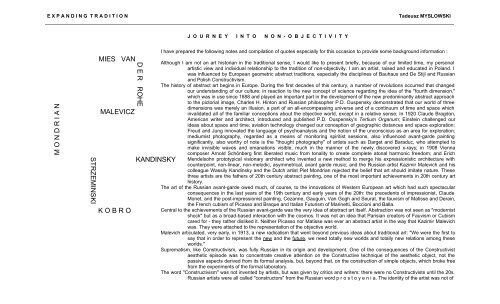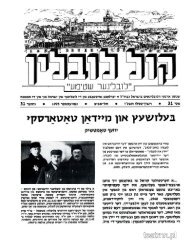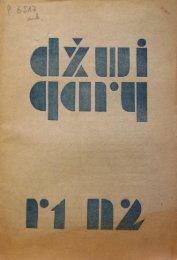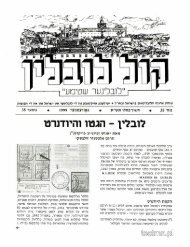malevicz mies van der rohe kandinsky strzeminski kobromondrian
malevicz mies van der rohe kandinsky strzeminski kobromondrian
malevicz mies van der rohe kandinsky strzeminski kobromondrian
Create successful ePaper yourself
Turn your PDF publications into a flip-book with our unique Google optimized e-Paper software.
E X P A N D I N G T R A D I T I O N<br />
Tadeusz MYSLOWSKI<br />
J O U R N E Y I N T O N O N - O B J E C T I V I T Y<br />
I have prepared the following notes and compilation of quotes especially for this occasion to provide some background information :<br />
M O N D R I A N<br />
STRZEMINSKI<br />
MIES VAN D E R ROHE<br />
MALEVICZ<br />
K O B R O<br />
KANDINSKY<br />
Although I am not an art historian in the traditional sense, I would like to present briefly, because of our limited time, my personal<br />
artistic view and individual relationship to the tradition of non-objectivity. I am an artist, raised and educated in Poland. I<br />
was influenced by European geometric abstract traditions, especially the disciplines of Bauhaus and De Stijl and Russian<br />
and Polish Constructivism.<br />
The history of abstract art begins in Europe. During the first decades of this century, a number of revolutions occurred that changed<br />
our un<strong>der</strong>standing of our culture: in reaction to the new concept of science regarding the idea of the "fourth dimension,"<br />
which was in use since 1888 and played an important part in the development of the new predominantly abstract approach<br />
to the pictorial image, Charles H. Hinton and Russian philosopher P.D. Ouspensky demonstrated that our world of three<br />
dimensions was merely an illusion, a part of an all-encompassing universe and of a continuum of time and space which<br />
invalidated all of the familiar conceptions about the objective world, except in a relative sense; In 1920 Claude Bragdon,<br />
American writer and architect, introduced and published P.D. Ouspensky's Tertium Organum; Einstein challenged our<br />
ideas about space and time; aviation technology changed our conception of geographic distances and space exploration;<br />
Freud and Jung innovated the language of psychoanalysis and the notion of the unconscious as an area for exploration;<br />
mediumist photography, regarded as a means of monitoring spiritist sessions, also influenced a<strong>van</strong>t-garde painting<br />
significantly, also worthy of note is the "thought photography" of artists such as Darget and Baraduc, who attempted to<br />
make invisible waves and emanations visible, much in the manner of the newly discovered x-rays; in 1908 Vienna<br />
composer Arnold Schönberg first liberated music from tonality to create complete atonal harmonic freedom; and Erich<br />
Mendelsohn prototypical visionary architect who invented a new method to merge his expressionistic architecture with<br />
counterpoint, non-linear, non-melodic, asymmetrical, a<strong>van</strong>t garde music; and the Russian artist Kazimir Malevich and his<br />
colleague Wassily Kandinsky and the Dutch artist Piet Mondrian rejected the belief that art should imitate nature. These<br />
three artists are the fathers of 20th century abstract painting, one of the most important achievements in 20th century art<br />
history.<br />
The art of the Russian a<strong>van</strong>t-garde owed much, of course, to the innovations of Western European art which had such spectacular<br />
consequences in the last years of the 19th century and early years of the 20th: the precedents of impressionist, Claude<br />
Monet, and the post-impressionist painting, Cezanne, Gauguin, Van Gogh and Seurat, the fauvism of Matisse and Derain,<br />
the French cubism of Picasso and Braque and Italian Futurism of Marinetti, Boccioni and Balla.<br />
Central to the achievements of the Russian a<strong>van</strong>t-garde was the very idea of abstract art itself. Abstraction was not seen as "mo<strong>der</strong>nist<br />
shock" but as a broad-based interaction with the cosmos. It was not an idea that Parisian creators of Fauvism or Cubism<br />
cared for - they rather disliked it. Neither Picasso nor Matisse was ever an abstract artist in the way that Kazimir Malevich<br />
was. They were attached to the representation of the objective world.<br />
Malevich articulated, very early, in 1913, a new radicalism that went beyond previous ideas about traditional art: "We were the first to<br />
say that in or<strong>der</strong> to represent the new and the future, we need totally new worlds and totally new relations among these<br />
worlds."<br />
Suprematism, like Constructivism, was fully Russian in its origin and development. One of the consequences of the Constructivist<br />
aesthetic episode was to concentrate creative attention on the Constructive technique of the aesthetic object, not the<br />
passive aspects <strong>der</strong>ived from its formal analysis, but, beyond that, on the construction of simple objects, which broke free<br />
from the experiments of the formal laboratory.<br />
The word "Constructivism" was not invented by artists, but was given by critics and writers: there were no Constructivists until the 20s.<br />
Russian artists were all called "constructors" from the Russian word p r o s t o y e n i a. The identity of the artist was not of
the Bohemian, but rather modeled after the scientist, technician or architect. In the place of classical subtractive sculpture traditions such as carving, the Constructivists instead<br />
were building objects, engineering and exploring space.<br />
A very significant moment for art history occurred in 1915. Malevich, in Petrograd, in his "0.10" exhibition, surprised the public with his exhibition of 39 abstract, Suprematist paintings<br />
showing geometric shapes on white backgrounds, among them the celebrated B l a c k S q u a r e. For Malevich, this was the ultimate in non-representational art, it was the<br />
birth of Suprematism. The Black Square was a celebration of the Suprematist idea at its purest. "I felt only night within me and it was then that I conceived the new art which I<br />
call Suprematism," Malevich said. Into it had been absorbed all the colors of the rainbow, and out of it might emerge all possible geometric forms, and all possible<br />
constellations. It was not Malevich's intent to produce ornaments but to express the feelings of rhythm. The cross, the circle, the rectangle were made by revolving, splitting and<br />
overlapping the image, a vocabulary of a higher dimension based on the analysis of the fourth dimension of forms. Malevich thought the art transcended religion and that<br />
Suprematism was the most spiritual and purest form of art.<br />
In the words of Malevich:<br />
"In my desperate attempt to liberate art from the useless burden of the object, I sought refuge in the form of the square, and exhibited a picture that represented nothing but a<br />
black square on a white ground I have broken the ring of the horizon and escaped from the circle of things in which the artist and all natural forms are enclosed with that great<br />
dream of escape into a weightless other realm."<br />
Suprematism was the single most impressive idea that Malevich left in his artistic legacy, and it affected the development not only of Russian art, but also of European and American art.<br />
Malevich's Black Square and his graphic work introduced another component into the artistic vocabulary of 20th century notions of black and white as colors. Previously, black<br />
was the color of outline, the articulation of narrative, but Malevich was interested in lithography and architecture, the "colorless arts" in which black and white constituted the<br />
construction.<br />
His colleague, Alexan<strong>der</strong> Rodchenko, influenced by the Suprematism of Malevich, turned to photography as a primary medium, and Sergei Eisenstein became involved with cinema. Other<br />
artists, in the same manner, were involved with the art of graphics, advertising and propaganda.<br />
The manifestoes of the Constructivist movements varied from country to country. Formally, what these international artists shared was an interested in the purity of form, non-objective<br />
painting without modeling or perspective and a flattening of the picture plane. They viewed the arts as an integrated contribution to a functional society, including architecture<br />
and typography. In Russia it was Suprematism, in the Netherlands, Piet Mondrian and Theo Van Doesburg originated Neo-plasticism. In 1918, French purism was championed<br />
by Le Corbusier, Amadee Ozenfant and Constantin Brancusi.<br />
In 1921, two comrades of Malevich, Wladyslaw Strzeminski and Katarzyna Kobro, took his ideas with them to Poland. Strzeminski developed a distinct variant of Constructivism called<br />
"Unism." It had ideological ties to Russian Suprematism, to Dutch Neo-plasticism and to the Bauhaus. It also had its own national characteristics. In his painted compositions,<br />
he tried to achieve an absolute unity and homogeneity of planes, he strove to liberate art in an absolute manner from the incidental and intuitive, to liberate it from all contrasts<br />
of values, colors and lines.<br />
Katarzyna Kobro, Strzeminski's wife, developed her own theory of spatial composition, called "Spatial Sculpture." Kobro's work was characterized by her will to unite a sculptural form with<br />
its surroundings, it was architectural sculpture in which dimensions and surfaces were organized in relations determined through mathematical calculation. One of the most<br />
important contemporary art critics, Yve-Alain Bois, wrote about Kobro's theory of sculpture in his book Painting as Model as one of the most elaborate of our century, and the 15<br />
or so sculptures which illustrate it, all by Kobro, are among the most astonishing.<br />
The first Polish Constructivist group began in Warsaw. It was called "Blok." Members of Blok un<strong>der</strong>scored the ideals of the "logic of the machine" and the "technicist" approach that<br />
characterized works of art matching contemporary life.<br />
Another very important a<strong>van</strong>t-garde Constructivist artist, Henryk Stazewski, called the "last of the Constructivists," who I met in 1979 in Warsaw and who I saw in his studio from time to<br />
time throughout the years, for his part, introduced what he called the "system of contrast," subjecting his abstract painting to the logic of contemporary civilization. In the difficult<br />
time in Poland during the 60s, I regarded him as hero because he was a part of the great utopian a<strong>van</strong>t-garde, friend of Malevich, Mondrian and Le Corbusier.<br />
In 1926, another interesting thing happened: because Malevich was of Polish origin, Strzeminski, Kobro and Stazewski attempted to help him obtain the right of permanent residence in<br />
Poland in 1927. This ended in failure due to government bureaucracy.<br />
In the 1930s, Strzeminski originated the idea of creating one of the first international Museums of 20th Century Art. It was established by members of the Polish "A.R." (Revolutionary Artists<br />
group) who collected more than one hundred pieces of international a<strong>van</strong>t-garde art during the 1920s and 30s. The museum was opened to the public in 1931 in Lodz, an<br />
industrial, proletarian city. Professor Andrzej Turowski, a scholar of the European a<strong>van</strong>t-garde, stated, "The Lodz Museum has been able to maintain the continuity of the<br />
a<strong>van</strong>t-garde ideas, implanted by Strzeminski, thus creating the significant basis and the point of reference for mo<strong>der</strong>n art in its entirety.
T R A N S - A T L A N T I C A R T I S T I C I M M I G R A T I O N + E X I L E S<br />
In the beginning of the century, the American public paid little attention to European a<strong>van</strong>t-garde art. The first gallery that was concerned with this idea was Alfred Stieglitz's Gallery "291,"<br />
which was opened around 1905. Stieglitz was a photographer and visionary who was the first to establish a connection between New York and Paris, allowing Americans to be<br />
aware of the latest developments in European art.<br />
In February 1913 the New York Armory show presented some 1,300 works of European and American mo<strong>der</strong>n artists. The show was the most important and controversial groundbreaking<br />
event in the history of American art. It signified an end to the old dominance of traditional and academic art and architecture. Later, the show traveled to Boston and Chicago.<br />
Following the Armory show, Katherine Dreier and Marcel Duchamp founded the Société Anonyme in New York with the purpose of exhibiting international a<strong>van</strong>t-garde art. By showing<br />
European mo<strong>der</strong>nism to an American audience, the Société played a crucial role in the New York art world. It greatly helped establish the abstract movement in America and<br />
helped foster the future of American contemporary art. 1<br />
In 1927 the Société un<strong>der</strong>took an international review of mo<strong>der</strong>n art at the Brooklyn Museum. This show included the first exhibition of two Neo-plastic paintings by Piet Mondrian. In the<br />
same year A.E. Gallatin opened the Gallery of Living Art (known after 1933 as the Museum of Living Art) at New York University. Its collection offered access to the story of<br />
mo<strong>der</strong>n European art from Cézanne and Cubism to Neo-plasticism and Constructivism. For Dreier and Gallatin abstraction was the future, the essence of mo<strong>der</strong>nism, and both<br />
looked to Americans for the development of mo<strong>der</strong>nism. 2<br />
In 1933, after the Gestapo had padlocked the doors of the Bauhaus, numerous Bauhaus students and faculty members, together with other European artists fled to America, to New York<br />
and Chicago, as the Nazis threatened the so-called "degenerate" artists. This immigration symbolized the passing of progressive art lea<strong>der</strong>ship from Moscow-Berlin-Paris, to<br />
New York City and Chicago. The presence of these European artists in New York in the early 1940s had an enormous impact on the evolution of post-war art in this country.<br />
They brought a<strong>van</strong>t-garde art history with them.<br />
To mention a few names: Josef Albers, Anni Albers, Marcel Breuer, Herbert Bayer, the European Surrealists, André Breton, Luis Bunuel, Salvador Dali, Marcel Duchamp, Yves Tanguy,<br />
Matta, Joan Miró, Andre Masson, Max Ernst, Lyonel Feininger, Andreas Feininger, Naum Gabo, Mies <strong>van</strong> <strong>der</strong> Rohe, Hans Richter, Laszlo Moholy-Nagy, Lucio Moholy, Walter<br />
Gropius, Johannes Itten, Fre<strong>der</strong>ick Kiesler, Igor Stravinsky, Arnold Schönberg, Elie Nadelman. These great figures were welcomed and appreciated by American institutions,<br />
and were given the opportunity to explore and realize their ideas. Walter Gropius was made head of the School of Architecture at Harvard, Moholy-Nagy opened a new<br />
Bauhaus (later the Chicago Institute of Design, which trained generations of students), Albers opened a rural Bauhaus in North Carolina at Black Mountain College and later<br />
taught at Yale, Mies <strong>van</strong> <strong>der</strong> Rohe was installed as Dean of architecture at the Armor Institute in Chicago, Hans Richter went to the City University in New York to explore<br />
experimental animated films, Feininger was employed as a photographer for Life Magazine, Kiesler was teaching at Yale University, the Julliard School of Music and Columbia<br />
University. Erich Mendelsohn was associated with the University of California in Los Angeles. And now we can see and we are amazed by their enormous legacy in<br />
contemporary art, as they produced a whole generation of artists in America influenced by their ideals.<br />
I would like to end this text with the immigration of Piet Mondrian, which was the culmination and completion of the arrival of the European a<strong>van</strong>t-garde in New York. Because of the<br />
displacement caused by World War II, I, as a European artist, had to come to the United States to trace and recapture my roots in the artistic legacy of the European<br />
a<strong>van</strong>t-garde. I personally, although indirectly, encountered Mondrian through my friendship with his close associate Harry Holtzman, who in 1934 at age 22 went to Paris to visit<br />
Mondrian. When the second World War broke out, Harry Holtzman encouraged Mondrian to come to America. Mondrian arrived in New York in October of 1940. Harry saw him<br />
daily and not only found him an apartment and paid his rent but also introduced him to an artistic world enriched by the arrival of other wartime exiles, among them André<br />
Breton, Marcel Duchamp, Marc Chagall, Max Ernst and Fernand Léger. Mondrian was Harry's mentor to the last day of his life. Piet Mondrian died at age 72 on February 1,<br />
1944. Harry Holtzman, named in Mondrian's will as testamentary legatee and executor, opened the studio to the public for six weeks. I met Holtzman in January of 1979 and<br />
through the years developed a friendship with him. And I feel that through his reminiscences I met Mondrian. And for that I am very grateful.<br />
In the fall of 1984, my wife, Irena Hochman, opened a gallery, Carpenter + Hochman, in New York and Dallas. We couldn't think of a better way of showing our admiration or of indicating<br />
the gallery's aesthetic than to ask Harry for permission to show the last works of Mondrian. My involvement with this exhibition was my personal encounter with Mondrian.<br />
To conclude, I am very curious to know, and I question what you, as a new generation of students, think about this particular history of the a<strong>van</strong>t-garde from a post-Utopian perspective?<br />
And I am also curious to know what areas you will chose to explore?<br />
If you want to know more about my personal view of this particular movement or about my work in this exhibition, please feel free to ask me any questions. I hope I will be able to provide<br />
you with the answers.<br />
Transcript of a lecture delivered by Tadeusz Myslowski for the occasion of the exhibition "Expanding Tradition;" DePaul University Art Gallery, Chicago; January 17 - March 14, 1997; Marlena Novak, curator.<br />
1 Green, Martin, New York 1913/ The Armory Show and the Paterson Strike Pageant, Charles Scribner's Sons, New York, 1988.<br />
2 Hunnisett, Christine, Generations of Geometry/ Abstract Painting in America since 1930, Whitney Museum of American Art, New York, 1987.
For further reference:<br />
Tom Wolfe, From Bauhaus to Our House, New York: Farrar Straus Giroux, 1981.<br />
Museum Folkwang Essen, Constructivism in Poland 1923 - 1936, BLOK Praesens a.r., 1973.<br />
Museum Stuki, Wladyslaw Strzeminski 1893 - 1952, Lodz, Poland, 1993.<br />
Museum Abteiberg Monchengladbach, Kobro, Edition Wienand Koln, Germany, 1991.<br />
Yve-Alain Bois, Painting as Model, Cambridge, Massachusetts: An October Book/MIT Press, 1990.<br />
Willy Rotzler, Constructivism and the Geometric Tradition, New York: McCrory Corporation, 1984.<br />
Ellen Lupton and J. Abbot Miller, ed., The ABC's of the Bauhaus and Design Theory, London: Thames and Hudson, 1993.<br />
George R. Collins, Visionary Drawings of Architecture and Planning: 20th Century through the 1960s, MIT Press, 1979.

















